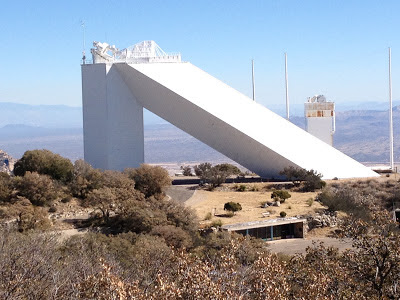We were up early this morning, and on a mission.
This is the sunrise that greeted us across the parking lot. As you can see, there are a lot of rv's hanging here, and there's still lots of room.
We had a quick breakfast in the casino and a cup of coffee and headed southwest out of Tucson. About 50 miles out, we found the Kitt Peak National Observatory. It's located on Kitt Peak on the Tohono O'odham reservation. The peak is named for Phillippa Kitt, the sister of the surveyor that first mapped the area, George Roskruge. A federal agency, NOAO, the National Optical Astronomical Observatories agency, under the funding of the NSF, the National Science Foundation maintains the facility. Blah, Blah. Read tax dollars at work. In any case, there are 25 optical telescopes and 2 radio telescopes on Kitt Peak, with all but 3 being funded and used by a variety of educational consortiums. No single university or agency can support a telescope, so a group will collaborate and share expenses as well as equipment time. Good use of resources, I'd say.
Our first tour was through the McMath-Pierce Solar Telescope. This device, shown above, is some 200+ feet above ground, and another 300+ below. The slanted portion is built at precisely 31.9 degrees to allow for the variation of the earth's axis relative to the sun, and is basically a hollow tube with moveable mirrors inside that reflect and position the suns image to emphasize different events. Todays study involved solar flares (although the staff prefer more precise nomenclature) and we were allowed into the lab to see what was happening and to talk with a young man who was working there.
The Solar Telescope was the first telescope built on Kitt Peak, primarily because Dr. McMath, the first administrator, was deeply involved in solar studies back in the late '50's. I guess if you're the boss, you can get what you want, eh?
Our second tour was of the 2.1 meter telescope. We were allowed to peek through each of two eyepieces, even though that type of instrument is no longer used in research. All images are received digitally, these days, and computer enhanced, never to be touched by human hands. The eyepieces on this 'scope are left in place as a tribute to "the old days".
The eyepieces can be seen just above the yellow plastic protector cups. One eyepiece was filtered to a specific element, providing a picture of the sun that was blue in one eyepiece, and yellow in the other.
Those of you that know telescopes will note that this is not a 2.1 meter 'scope. It is actually an eyepiece apparatus "faked" to receive the image that the 2.1 is collecting, so that what we saw in each eyepiece was indeed the actual 2.1 image.
Our third and longest tour of the day was to the 4.1 meter Mayall Telescope. This 187 foot tall structure is built of 10 hexahedrons and can be seen from 50 miles away. It was completed in 1970 and is used primarily for infrared and faint visible light explorations.
The dome weighs 500 tons, yet only requires a 1/2 horsepower electric motor to rotate. While we were approaching the telescope, the staff began a rotation testing procedure that required 180 degree rotation. From the outside, at the base, the rotation was completely silent. Remarkable engineering.
This pic does absolutely no justice to the size of the telescope, but know this: the mirror is placed about half way up the light colored object in the center, on a plane with the darker horizontal shadow. The mirror is 158" in diameter and weighs 15 tons. It is polished to within 1 millionth of an inch. The blue circular shape is the equatorial mount and moves the 92 foot long telescope as required. The telescope and it's concrete and steel supporting structure are completely separate from the building structure to minimize vibration.
This pic is from the exterior observation deck of the 4.1 meter 'scope. The peak in the distance is considered to be the single most revered object in local native american culture, because it is the place where the native peoples emerged from their hiding place after the world was destroyed by water. Ironically, Kitt Peak is the second most sacred place in Tohona O'odham culture, but their interest in the heavens and their desire to further astronomical knowledge led the elders to allow the construction of the observatories. The annual lease payments subsidize many tribal activities.
All in all, on of the most interesting tours we've been on.
Last night in Tucson, so we'll (hopefully) post from wherever we land tomorrow!






No comments:
Post a Comment